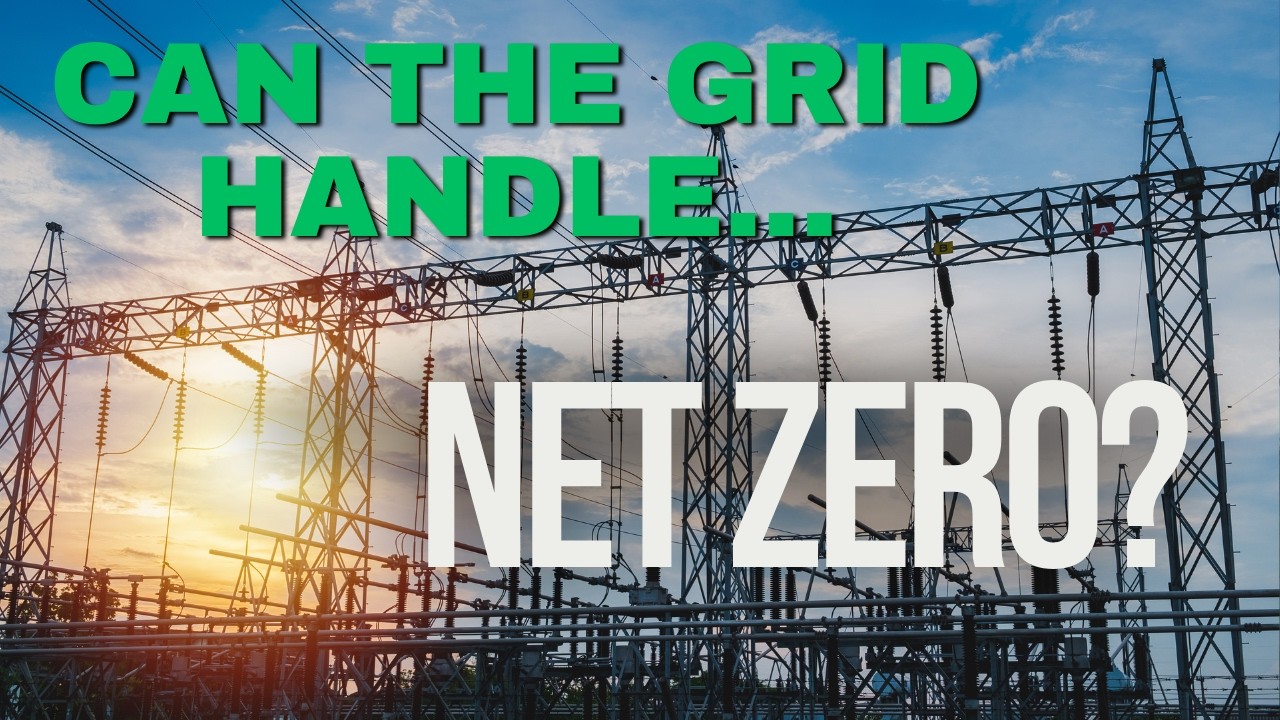
I was at a community event a few weeks ago, talking to people about how we might respond to climate change, as one of the sessions finished a gent left the room saying ‘that’s all well and good, you didn’t mention the grid, the grid can’t handle it’. Which to some extent is right, if not a lacking a bit of nuance, so what does the electricity grid mean when it comes to decarbonisation? Would the grid be a barrier to moving to heat pumps and electric vehicles? Or is it an enabler? Where should we be concerned, and where can we be hopeful?
Have a look at Northern Power Grid’s demand heat map – https://www.northernpowergrid.com/demand-availability-map
Some great mythbusters on the National Grid website – https://www.nationalgrid.com/the-great-grid-upgrade/clean-energy-myths
Switch to Octopus and get £50 off – https://share.octopus.energy/azure-hero-218
————————————————————————————————————-
Get a free quote for heat pumps through The Eco Experts – https://quotes.theecoexperts.co.uk/heat-pumps?cid=652e544dc95d2
———————————————————————————————————————————————————–
https://www.buymeacoffee.com/lowcarbontom
———————————————————————————————————————————————————–
Book in a call to talk through any thoughts linked to your project – https://calendly.com/low-carbon-tom
———————————————————————————————
Have a look at Ripple – https://rippleenergy.com?ogu=6499
I mentioned the H word briefly – here is a helpful article to explain why we won’t be using Hydrogen as a direct replacement for fossil fuels in heating – https://www.cleanenergywire.org/factsheets/qa-heating-hydrogen-clean-alternative-or-pipe-dream
and transport – https://www.thecarexpert.co.uk/why-hydrogen-cars-are-not-the-answer/#:~:text=Unfortunately%2C%20a%20hydrogen%20fuel%20cell,in%20delivering%20hydrogen%20to%20customers.
source







Don't forget there are many homes that have electric showers and storage heaters. I'm an electrician and i've been improving energy efficiency of lighting and motors for over a decade , there's still a long way to go. V2G will enable my Ioniq 5 to provide 50+kwh of storage for my home alone.
The people who say its not possible to make the energy transition, that its just too hard, strike me as rather pathetic. Our Victorian and edwardian ancestors built the town gas infrastructure, as well was the water and sewage system, the canals and the railways. In the early part of the 20th century we built the core of electricity grid, in the 1960s the natural gas network was built and millions of homes were converted from town gas to natural gas, and the motorway network was constructed. In addition we built the phone network, and then the broadband and mobile phone networks. They complain that Georgian and Victorian houses weren't built to accomodate heat pumps. Well guess what, they weren't built to accommodate gas central heating, or electricity, or even for the most part, indoor bathrooms or modern kitchens, all these things were retro fitted. I think that if our forebears heard the pathetic "it too hard" whining coming from this crowd, they would be embarrassed and wonder what the hell happened to their decendants.
At a household level the lack of three phase may become more and more of an issue and my feeling is we may need a nationwide roll out of three phase. Most houses have a 100Amp supply. If you have a couple of EV' and a heat pump, plus home battery you will exceed this. A friend recently had three phase to his house which cost him £45k. I feel this limitation may really hold back full electrification. I'm hoping I've got it wrong and an electrician can inform me otherwise?
A lot of EV owners eventually fit solar panels, That will help the grid.
Underwater cables are at risk of sabotage. A Russian ship has for some time been sniffing around North Sea offshore facilities. Maybe this is just to get accurate GPS or GLONASS for targeting or explosive devices have been buried nearby. Hopefully the Navy has been checking the latter out but do not hold your breath.
The grid has never been ready to handle UK electricity needs, that's why it has always been extended and grown. People that say the grid can't handle demand are denying history or are ignorant of it.
Roughly speaking electrification would require about a third less energy than the current system of mostly fossil fuels. But of course if we demand more energy for things like data centres and AI then it will get increasingly difficult.
5:49 uk "electricity " demand is already dropping. Down from 375twh in 2007 to 306twh in 2023.
A couple of weeks ago I was at the Denver airport. They have really large car parks – 50,000 cars just at the airport, plus fleets of rental cars and places just off the airport. Imagine 10,000 parked electric cars with 50 kW batteries. That's 500 kW of storage. Of course you'd need to wire every space, have bidirectional charging on the cars and make sure the cars were charged back up before the owner came back from a trip. But the system wouldn't need all the cars. Give the owners free parking. The airport has 54 square miles total, plenty of room for solar.
Warren Buffett owns 16.45% of Berkshire Hathaway
One nuclear plant could see 45,000 rooftop solar systems shut off each day
Sophie Vorrath
22 July 2024 2:11 PM
“This means the equivalent of an average of 45,000 Queensland household solar systems would need to be shut off every day. We would be shutting off cheap energy, like people’s rooftop solar, to allow expensive nuclear power to run.
“This report shows that, even if large-scale nuclear energy can be built in 15 years in Australia, we won’t need it.”
The new data supports what just about every other informed participant in Australia’s energy transition – from the market operator, to regulators, policy makers, utilities and the energy market itself – understand, and have been saying, about what will and won’t work in a grid that is changing dramatically.
In March, Simon Holmes à Court showed the Smart Energy Council conference how the hollowing out of daytime demand from rooftop solar creates the “complete opposite” energy demand profile of what a new nuclear power station wants to do.
And just last week, the University of Western Australia’s Bill Grace gave his own detailed analysis of why the sort of baseload power nuclear provides “is no longer necessary or commercially viable.”
QCC energy strategist Claire Silcock says this week’s report confirms that nuclear power has no place on Australia’s grid and isn’t what is needed to meet future energy demands at least cost.
“What we need is flexible generation and storage which can move energy from when we have lots of it, in the middle of the day, to when we need it overnight,” Silcock says. “That is not how nuclear power stations work.
“The earliest we could possibly build a nuclear power plant in Australia is 2040 – by then we will have abundant renewable energy and technology like batteries and pumped hydro will be providing the flexible storage we need to support that renewable energy.
“Nuclear is also much more expensive than renewable energy backed by storage,” she adds.
“It’s as clear as day that the federal Coalition’s nuclear plan is a fantasy to delay the closure of Australia’s polluting coal-fired power stations.
“We would like to see the federal opposition focus on a real plan for bringing down emissions and power prices and that would mean backing renewable energy and storage.”
https://reneweconomy.com.au/
Nuclear
Rondo Heat Battery is a new 'old' technology. 😮
Look at the video. 😊
20million rooftops and vehicles in Australia.
20million 6.6kW rooftop PV and
20million v2g EV oversized battery combined can totally unload the national electrical grid.
The national grid is fragile and lightweight and extremely expensive, 10decades to build.
1million km x $1million per km is
$TRILLIONS.
To increase capacity 7times to replace fossil fuels is an insane cost.
So, the unloaded grid can now take excess rooftop PV and BVs battery electricity and supply the new industrial users moving away from fossil fuels.
The rooftop PV can replace imported petroleum and gas heating and cooking and hotwater and grid electricity and save $TRILLIONS on new grid capacity.
Rooftop PV panels shade 😎 hot roofs and reduces air-conditioning loads.
Remember vehicles are parked 23hrs every day. That is why 10,000 miles per year (10,000 or 8,760 hours per year).
The National Grid website has a page dedicated to "myths" – just point people there
Perhaps the reason stated, CO2 is based on poor science.want to convince Me?
Energy we never have made! All we do is conversion.
The biggest threat (probably in slowing the transition, not stopping it), in my opinion, is the relentless misinformation (presumably bankrolled by oil and gas interests) – with our willing gutter press happily printing the garbage or the curious countless paid 'contrarian' shills on YouTube et al spreading it
Can confirm having a heat pump, solar panels, home battery and EV that it's eyewateringly cheaper to run and it's only getting cheaper and cheaper as tech improves and the cost curves plummet – though it's impossible to convince others that I'm not lying, the misinformation is that pervasive and relentless to the public, even family members parrot back Daily Mail nonsense to me
Good video.
I just watched again without distractions. 😊
Tipping points for gas pipelines is an excellent point.
£ per customer increases as number of customers reduces.
A little fossil fuel use in mid winter weeks is not a problem. 😊
With bigger nuclear generation you need bigger grid capacity and that is extremely expensive because the number of customers is fixed at millions and millions and millions.
So, millions of miles of grid.
If every customer needs 2times more electricity then the grid has to be basically rebuilt.
5times more electricity then 5times grid capacity rebuild 5times ?????
£TRILLIONS and TRILLIONS and decades and decades.
So rooftop PV (sun fussion) and basement nuclear fission. 😮😮😮😮
Hahaha 😊😊😊😊😊
The grid cost themselves is overlooked.
The £TRILLIONS bottle neck to the millions of customer's cash.
If the western world spends trillions for an estimated one tenth of a degree reduction, is that really worth the money?
With melting ice uncovering Viking settlements in Greenland, Roman paths over high alpine passes, and mining tools and infrastructure in northern USA, does this not show it’s been previously warmer than our current? What caused the previous warmings and climate changes? Could they not have been natural? Why did it cool from 1940’s to the late 1970’s when CO2 emissions were increasing?
If trillions are spent without answering a few questions, it will all be for nothing.
What about reductions in grid usage for refining petrol ? Here is an AI reponse
Refining, distributing, and delivering petrol in the UK involves significant energy consumption, including electricity. Here are some key points:
Refining: The process of refining crude oil into petrol is energy-intensive. It is estimated that refining a gallon of petrol requires around 4.8 kWh of energy, with a portion of this being electricity1.
Distribution and Delivery: Petrol stations in the UK use approximately 15,000 kWh of electricity per month on average. This figure can vary based on the size of the station and the number of pumps2.
Overall, the total electricity used in the entire process from refining to delivering petrol is substantial, contributing to the overall energy footprint of petrol as a fuel source.
Thanks for this video. Could we have some dates when things are likely to happen? Could we have more numbers on how much we need to expand the grid for example? Thanks for saying that 17% of the power in the UK is electrical. See https://www.youtube.com/watch?v=tofYY8kResE for some of this information.
I don't currently think Heat pumps can provide a majority solution for the UK, they are too expensive and have poor performance. The main problem is having such poor quality housing and poor quality building work, we need massive efforts in training and testing standards. The heat can come from mainly community Geothermal, possibly involving heat pumps, or thermal storage to take advantage of peak renewables.
Ultimately, in the present social system, it's the money grid that needs to be reworked as its ships mythical 'money' from those that think they need it to those that want to hoard it. The electricity companies, and the users are both stymied by the limitations of the money grid in our attempts to do the right thing.
Also we'll need to resolve the 'home island-ing' problem that currently prevent EV batteries and home batteries being interconnected for personal use during outages. No real available products, and important safety issues concerning back feeding the DNO grid [to be compared with meter bypassing..]. There will be folks in back offices working on the [technical] issues, but those pesky humans are a variable bunch!